Non-Intrusive Assessment of COVID-19 Lockdown Follow-Up and Impact Using Credit Card Information: Case Study in Chile
Abstract
1. Introduction
2. Materials and Methods
2.1. Geographical Location and Scope
2.2. Credit Card Data
2.3. Spatial Aggregation
2.4. Determination of Activity Pattern Duration
2.5. Topic Modeling of CCR Data
3. Results
3.1. CCR Activity Topics before the Pandemic
- Topic 0 “residential” is characterized by two high activity peaks during weekdays, localized around lunch and dinner times. Notice that the second peak on Fridays occurs later around 11 p.m., reflecting that people used to have a later dinner on this day. Also notice that the second peak on Sundays is much less pronounced, indicating that citizens were less prone to go out dining on Sunday evening.
- Topic 1 “leisure/commerce” presents three peaks during the weekdays located at 9 a.m., lunchtime, and around 7 p.m., roughly corresponding to times when people used to commute to or from school or work. During weekends, this pattern is more evenly distributed throughout the day. Notice that there are high activities in the early hours of Saturday and Sunday, corresponding to nightlife habits before the pandemic.
- Topic 2 “office areas” is characterized by a high and uniform activity during weekdays and less activity during weekends. During the day the main activity is between 09:00 a.m. and 18:00 p.m. and there is increasing activity at lunchtime (13:00 p.m.), corresponding to office areas activity.
- Topic 3 “rush hour” has peaks that roughly correspond to times when people are moving from or to the working place in office/business areas.
3.2. Change in Activity Topics Due to the Pandemic
3.3. Impact of Local Policies
3.4. Aggregate Activity Measurement of Impact
4. Discussion
5. Conclusions
Author Contributions
Funding
Institutional Review Board Statement
Informed Consent Statement
Data Availability Statement
Conflicts of Interest
References
- Cakmakli, C.; Demiralp, S.; Ozcan, S.K.; Yesiltas, S.; Yildirim, M.A. COVID-19 and Emerging Markets: The Case of Turkey; Technical Report 2011; Koc University—TUSIAD Economic Research Forum: Istanbul, Turkey, 2020. [Google Scholar]
- Sohrabi, C.; Alsafi, Z.; O’Neill, N.; Khan, M.; Kerwan, A.; Al-Jabir, A.; Iosifidis, C.; Agha, R. World Health Organization declares global emergency: A review of the 2019 novel coronavirus (COVID-19). Int. J. Surg. 2020, 76, 71–76. [Google Scholar] [CrossRef]
- Yan, Y.; Shin, W.I.; Pang, Y.X.; Meng, Y.; Lai, J.; You, C.; Zhao, H.; Lester, E.; Wu, T.; Pang, C.H. The First 75 Days of Novel Coronavirus (SARS-CoV-2) Outbreak: Recent Advances, Prevention, and Treatment. Int. J. Environ. Res. Public Health 2020, 17, 2323. [Google Scholar] [CrossRef]
- Barański, K.; Brożek, G.; Kowalska, M.; Kaleta-Pilarska, A.; Zejda, J.E. Impact of COVID-19 Pandemic on Total Mortality in Poland. Int. J. Environ. Res. Public Health 2021, 18, 4388. [Google Scholar] [CrossRef] [PubMed]
- Emmerich, F.G. Comparisons between the Neighboring States of Amazonas and Pará in Brazil in the Second Wave of COVID-19 Outbreak and a Possible Role of Early Ambulatory Treatment. Int. J. Environ. Res. Public Health 2021, 18, 3371. [Google Scholar] [CrossRef] [PubMed]
- Jindal, C.; Kumar, S.; Sharma, S.; Choi, Y.M.; Efird, J.T. The Prevention and Management of COVID-19: Seeking a Practical and Timely Solution. Int. J. Environ. Res. Public Health 2020, 17, 3986. [Google Scholar] [CrossRef] [PubMed]
- Frediansyah, A.; Tiwari, R.; Sharun, K.; Dhama, K.; Harapan, H. Antivirals for COVID-19: A critical review. Clin. Epidemiol. Glob. Health 2021, 9, 90–98. [Google Scholar] [CrossRef]
- Lagier, J.C.; Million, M.; Gautret, P.; Colson, P.; Cortaredona, S.; Giraud-Gatineau, A.; Honoré, S.; Gaubert, J.Y.; Fournier, P.E.; Tissot-Dupont, H.; et al. Outcomes of 3737 COVID-19 patients treated with hydroxychloroquine/azithromycin and other regimens in Marseille, France: A retrospective analysis. Travel Med. Infect. Dis. 2020, 36, 101791. [Google Scholar] [CrossRef]
- Gentile, I.; Maraolo, A.E.; Piscitelli, P.; Colao, A. COVID-19: Time for Post-Exposure Prophylaxis? Int. J. Environ. Res. Public Health 2020, 17, 3997. [Google Scholar] [CrossRef]
- Zhou, Y.; Hou, Y.; Shen, J.; Mehra, R.; Kallianpur, A.; Culver, D.A.; Gack, M.U.; Farha, S.; Zein, J.; Comhair, S.; et al. A network medicine approach to investigation and population-based validation of disease manifestations and drug repurposing for COVID-19. PLoS Biol. 2020, 18, e3000970. [Google Scholar] [CrossRef]
- Mishra, S.K.; Tripathi, T. One year update on the COVID-19 pandemic: Where are we now? Acta Trop. 2021, 214, 105778. [Google Scholar] [CrossRef]
- Liu, Y.; Morgenstern, C.; Kelly, J.; Lowe, R.; Jit, M. The impact of non-pharmaceutical interventions on SARS-CoV-2 transmission across 130 countries and territories. BMC Med. 2021, 19, 40. [Google Scholar] [CrossRef] [PubMed]
- Perra, N. Non-pharmaceutical interventions during the COVID-19 pandemic: A review. Phys. Rep. 2021. [Google Scholar] [CrossRef]
- Regmi, K.; Lwin, C.M. Factors Associated with the Implementation of Non-Pharmaceutical Interventions for Reducing Coronavirus Disease 2019 (COVID-19): A Systematic Review. Int. J. Environ. Res. Public Health 2021, 18, 4274. [Google Scholar] [CrossRef] [PubMed]
- Trabelsi, K.; Ammar, A.; Masmoudi, L.; Boukhris, O.; Chtourou, H.; Bouaziz, B.; Brach, M.; Bentlage, E.; How, D.; Ahmed, M.; et al. Sleep Quality and Physical Activity as Predictors of Mental Wellbeing Variance in Older Adults during COVID-19 Lockdown: ECLB COVID-19 International Online Survey. Int. J. Environ. Res. Public Health 2021, 18, 4329. [Google Scholar] [CrossRef] [PubMed]
- Salazar-Fernández, C.; Palet, D.; Haeger, P.A.; Román Mella, F. COVID-19 Perceived Impact and Psychological Variables as Predictors of Unhealthy Food and Alcohol Consumption Trajectories: The Role of Gender and Living with Children as Moderators. Int. J. Environ. Res. Public Health 2021, 18, 4542. [Google Scholar] [CrossRef]
- Bermejo-Martins, E.; Luis, E.O.; Sarrionandia, A.; Martínez, M.; Garcés, M.S.; Oliveros, E.Y.; Cortés-Rivera, C.; Belintxon, M.; Fernández-Berrocal, P. Different Responses to Stress, Health Practices, and Self-Care during COVID-19 Lockdown: A Stratified Analysis. Int. J. Environ. Res. Public Health 2021, 18, 2253. [Google Scholar] [CrossRef]
- Aguilar-Farias, N.; Toledo-Vargas, M.; Miranda-Marquez, S.; Cortinez-O’Ryan, A.; Cristi-Montero, C.; Rodriguez-Rodriguez, F.; Martino-Fuentealba, P.; Okely, A.D.; del Pozo Cruz, B. Sociodemographic Predictors of Changes in Physical Activity, Screen Time, and Sleep among Toddlers and Preschoolers in Chile during the COVID-19 Pandemic. Int. J. Environ. Res. Public Health 2021, 18, 176. [Google Scholar] [CrossRef]
- Mayen Huerta, C.; Cafagna, G. Snapshot of the Use of Urban Green Spaces in Mexico City during the COVID-19 Pandemic: A Qualitative Study. Int. J. Environ. Res. Public Health 2021, 18, 4304. [Google Scholar] [CrossRef]
- Carvalho, V.; Garcia, J.; Hansen, S.; Ortiz, A.; Rodrigo, T.; More, J. Tracking the COVID-19 Crisis with High-Resolution Transaction Data; Technical Report, Cambridge Working Papers in Economics 2030; Faculty of Economics, University of Cambridge: Cambridge, UK, 2020. [Google Scholar]
- Horvath, A.; Kay, B.; Wix, C. The COVID-19 Shock and Consumer Credit: Evidence from Credit Card Data. SSRN 2021. [Google Scholar] [CrossRef]
- Dunn, A.; Hood, K.; Driessen, A. Measuring the Effects of the COVID-19 Pandemic on Consumer Spending Using Card Transaction Data; Technical Report Working Paper WP2020-5; US Bureau of Economic Analysis: Suitland, MD, USA, 2020.
- Chen, H.; Qian, W.; Wen, Q. The Impact of the COVID-19 Pandemic on Consumption: Learning from High Frequency Transaction Data (July 1, 2020). Technical Report. SSRN 2020. [Google Scholar] [CrossRef]
- Bounie, D.; Camara, Y.; Fize, E.; Galbraith, J.; Landais, C.; Lavest, C.; Pazem, T.; Savatier Baptiste, C.D.P. Consumption Dynamics in the COVID Crisis: Real Time Insights from French Transaction & Bank Data; Technical Report 15474, CEPR Discussion Papers; Centre for Economic Policy Research: London, UK, 2020. [Google Scholar]
- Andersen, A.L.; Hansen, E.T.; Johannesen, N.; Sheridan, A. Pandemic, Shutdown and Consumer Spending: Lessons from Scandinavian Policy Responses to COVID-19. 2020. Available online: http://xxx.lanl.gov/abs/2005.04630 (accessed on 20 May 2021).
- Rios, S.A.; Muñoz, R. Land Use detection with cell phone data using topic models: Case Santiago, Chile. Comput. Environ. Urban Syst. 2017, 61, 39–48. [Google Scholar] [CrossRef]
- Ferres, L.; Schifanella, R.; Perra, N.; Vilella, S.; Bravo, L.; Paolotti, D.; Ruffo, G.; Sacasa, M. Measuring Levels of Activity in a Changing City. A Study Using Cellphone Data Streams. 2020. Available online: http://datascience.udd.cl/covid_ids_tef_01.pdf (accessed on 20 May 2021).
- Lösch, A. The Economics of Location; Yale UP: New Haven, CT, USA, 1954. [Google Scholar]
- Blei, D.M.; Ng, A.Y.; Jordan, M.I. Latent Dirichlet Allocation. J. Mach. Learn. Res. 2003, 3, 993–1022. [Google Scholar] [CrossRef]
- Hu, N.; Legara, E.F.; Lee, K.K.; Hung, G.G.; Monterola, C. Impacts of land use and amenities on public transport use, urban planning and design. Land Use Policy 2016, 57, 356–367. [Google Scholar] [CrossRef]
- Frias-Martinez, V.; Frias-Martinez, E. Spectral clustering for sensing urban land use using Twitter activity. Eng. Appl. Artif. Intell. 2014, 35, 237–245. [Google Scholar] [CrossRef]
- Yan, Y.; Schultz, M.; Zipf, A. An exploratory analysis of usability of Flickr tags for land use/land cover attribution. Geo-Spat. Inf. Sci. 2019, 22, 12–22. [Google Scholar] [CrossRef]
- Yuan, G.; Chen, Y.; Sun, L.; Lai, J.; Li, T.; Liu, Z. Recognition of Functional Areas Based on Call Detail Records and Point of Interest Data. J. Adv. Transp. 2020, 2020, 8956910. [Google Scholar] [CrossRef]
- Villas-Boas, S.B.; Sears, J.; Villas-Boas, M.; Villas-Boas, V. Are We #StayingHome to Flatten the Curve? Technical Report; UC Berkeley, Department of Agricultural and Resource Economics: Berkeley, CA, USA, 2020. [Google Scholar]
- Beyer, R.C.; Franco-Bedoya, S.; Galdo, V. Examining the economic impact of COVID-19 in India through daily electricity consumption and nighttime light intensity. World Dev. 2021, 140, 105287. [Google Scholar] [CrossRef]
- Goel, R.K.; Saunoris, J.W.; Goel, S.S. Supply chain performance and economic growth: The impact of COVID-19 disruptions. J. Policy Model. 2021, 43, 298–316. [Google Scholar] [CrossRef]
- Kaye, A.D.; Okeagu, C.N.; Pham, A.D.; Silva, R.A.; Hurley, J.J.; Arron, B.L.; Sarfraz, N.; Lee, H.N.; Ghali, G.; Gamble, J.W.; et al. Economic impact of COVID-19 pandemic on healthcare facilities and systems: International perspectives. Best Pract. Res. Clin. Anaesthesiol. 2020. [Google Scholar] [CrossRef]
- Golar, G.; Malik, A.; Muis, H.; Herman, A.; Nurudin, N.; Lukman, L. The social-economic impact of COVID-19 pandemic: Implications for potential forest degradation. Heliyon 2020, 6, e05354. [Google Scholar] [CrossRef] [PubMed]
- Mtimet, N.; Wanyoike, F.; Rich, K.M.; Baltenweck, I. Zoonotic diseases and the COVID-19 pandemic: Economic impacts on Somaliland’s livestock exports to Saudi Arabia. Glob. Food Secur. 2021, 28, 100512. [Google Scholar] [CrossRef]
- Kithiia, J.; Wanyonyi, I.; Maina, J.; Jefwa, T.; Gamoyo, M. The socio-economic impacts of Covid-19 restrictions: Data from the coastal city of Mombasa, Kenya. Data Brief 2020, 33, 106317. [Google Scholar] [CrossRef]
- Kaczmarek, T.; Perez, K.; Demir, E.; Zaremba, A. How to survive a pandemic: The corporate resiliency of travel and leisure companies to the COVID-19 outbreak. Tour. Manag. 2021, 84, 104281. [Google Scholar] [CrossRef]
- Chen, M.H.; Demir, E.; García-Gómez, C.D.; Zaremba, A. The impact of policy responses to COVID-19 on U.S. travel and leisure companies. Ann. Tour. Res. Empir. Insights 2020, 1, 100003. [Google Scholar] [CrossRef]
- Mendolia, S.; Stavrunova, O.; Yerokhin, O. Determinants of the community mobility during the COVID-19 epidemic: The role of government regulations and information. J. Econ. Behav. Organ. 2021, 184, 199–231. [Google Scholar] [CrossRef]
- Noland, R.B. Mobility and the effective reproduction rate of COVID-19. J. Transp. Health 2021, 20, 101016. [Google Scholar] [CrossRef]
- Chan, H.Y.; Chen, A.; Ma, W.; Sze, N.N.; Liu, X. COVID-19, community response, public policy, and travel patterns: A tale of Hong Kong. Transp. Policy 2021, 106, 173–184. [Google Scholar] [CrossRef] [PubMed]
- Hu, S.; Xiong, C.; Yang, M.; Younes, H.; Luo, W.; Zhang, L. A big-data driven approach to analyzing and modeling human mobility trend under non-pharmaceutical interventions during COVID-19 pandemic. Transp. Res. Part C Emerg. Technol. 2021, 124, 102955. [Google Scholar] [CrossRef]
- Borkowski, P.; Jażdżewska-Gutta, M.; Szmelter-Jarosz, A. Lockdowned: Everyday mobility changes in response to COVID-19. J. Transp. Geogr. 2021, 90, 102906. [Google Scholar] [CrossRef]
- Benita, F. Human mobility behavior in COVID-19: A systematic literature review and bibliometric analysis. Sustain. Cities Soc. 2021, 70, 102916. [Google Scholar] [CrossRef]

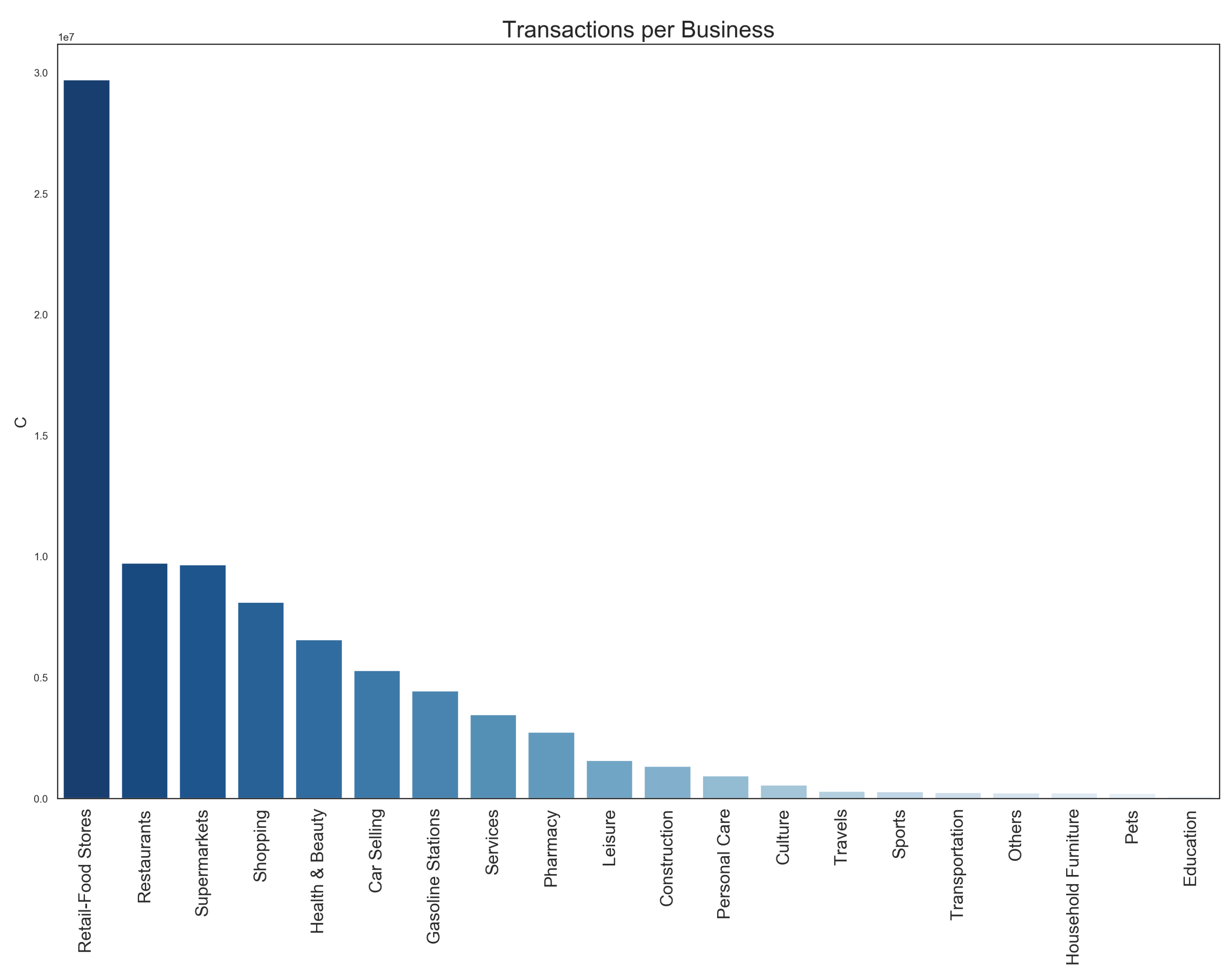
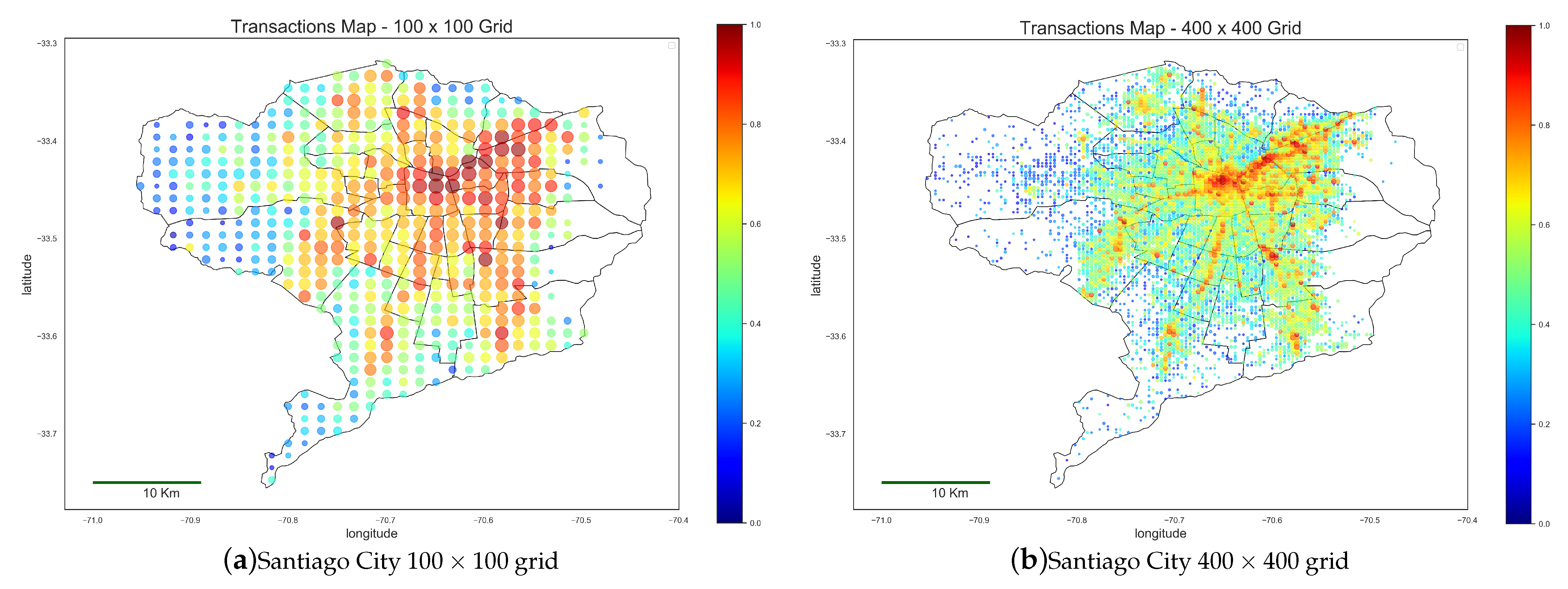
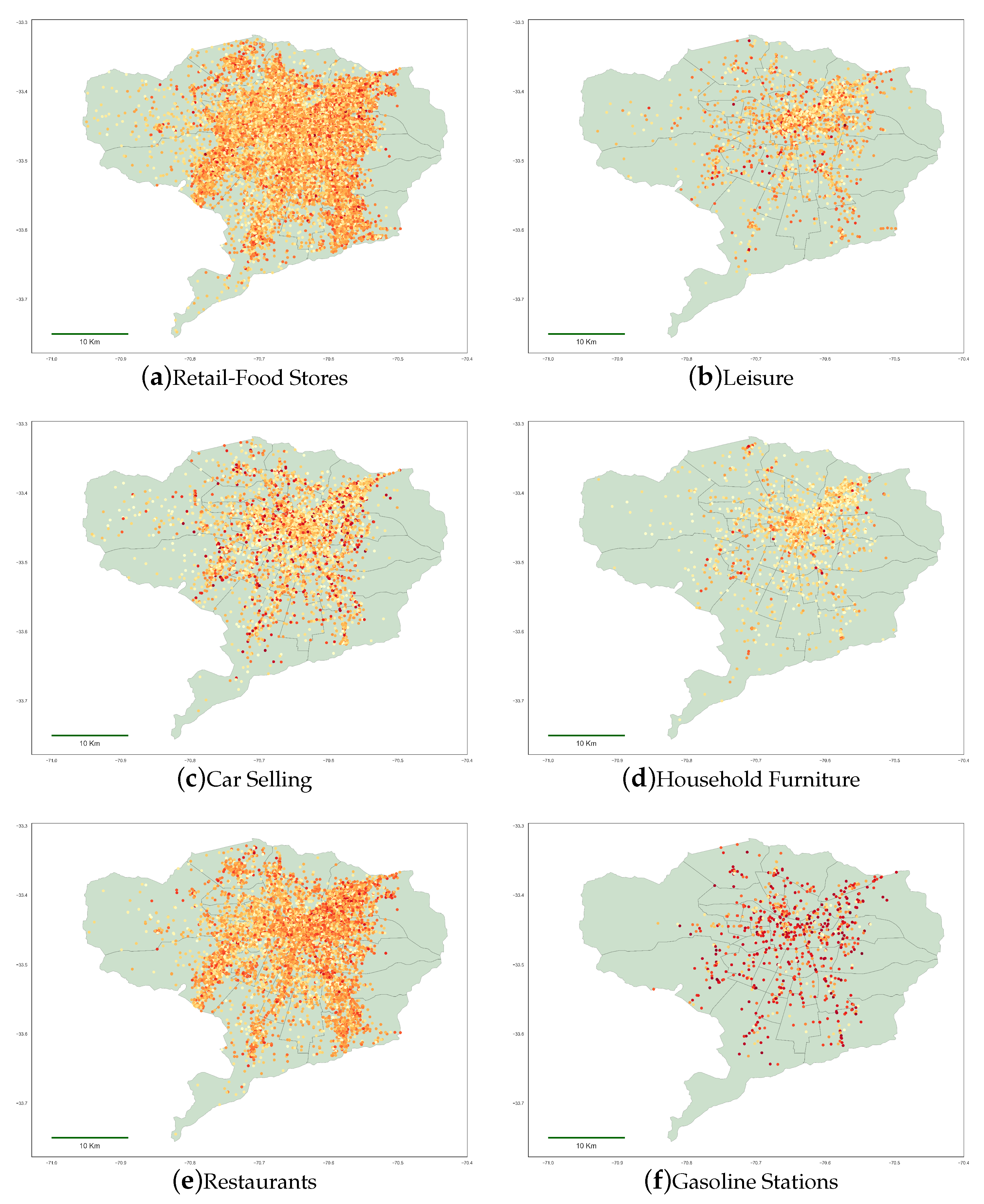
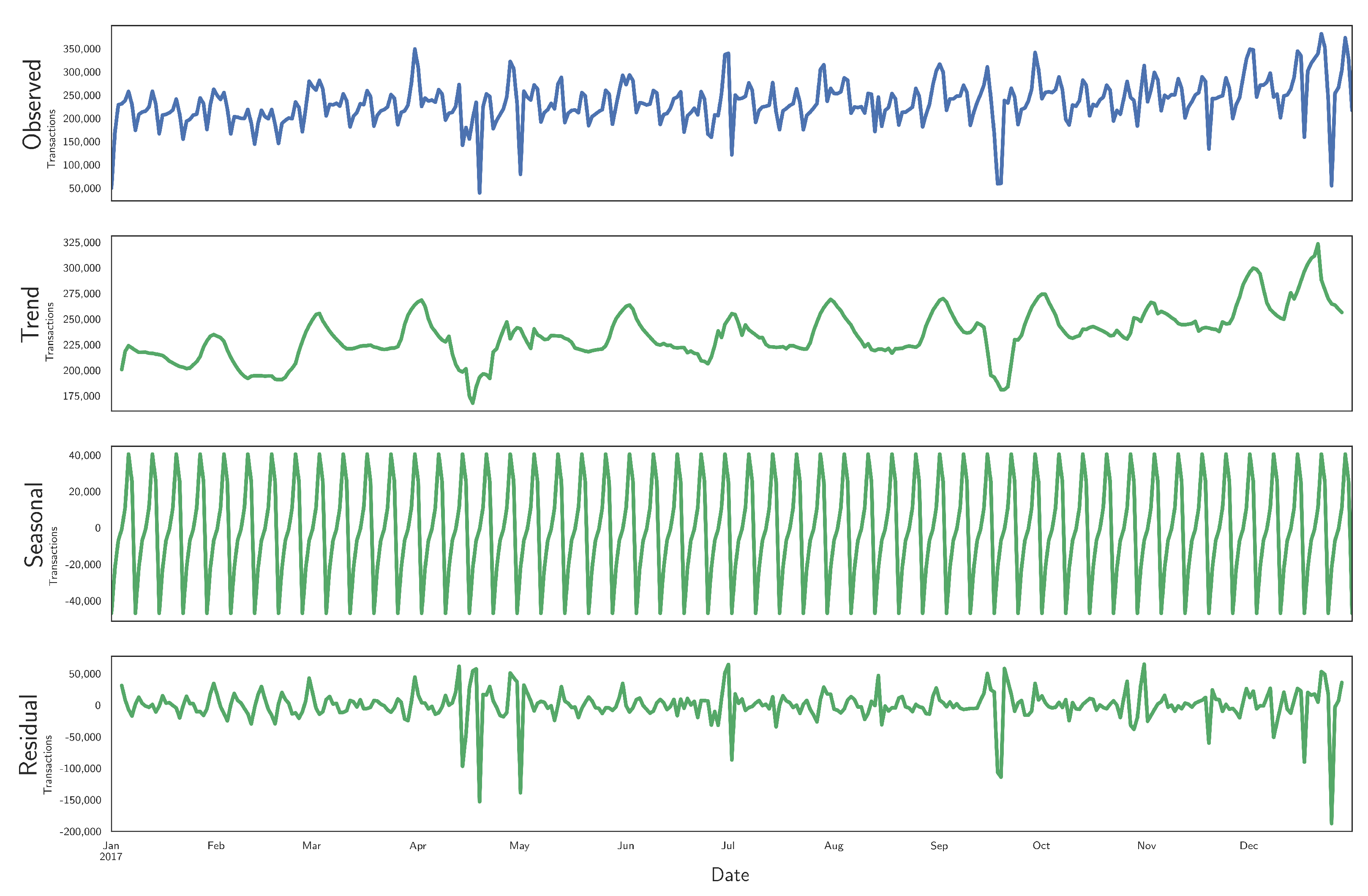
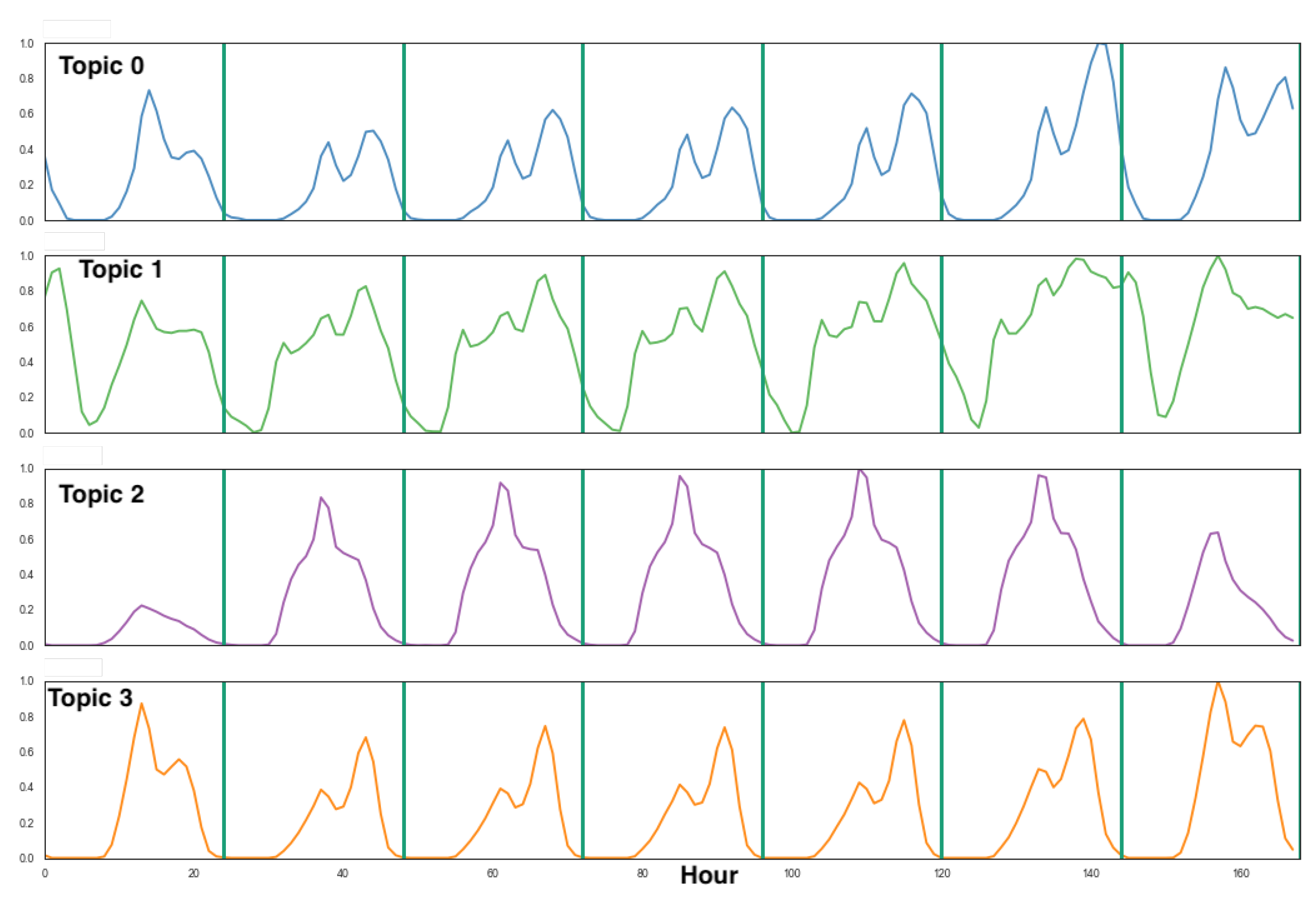
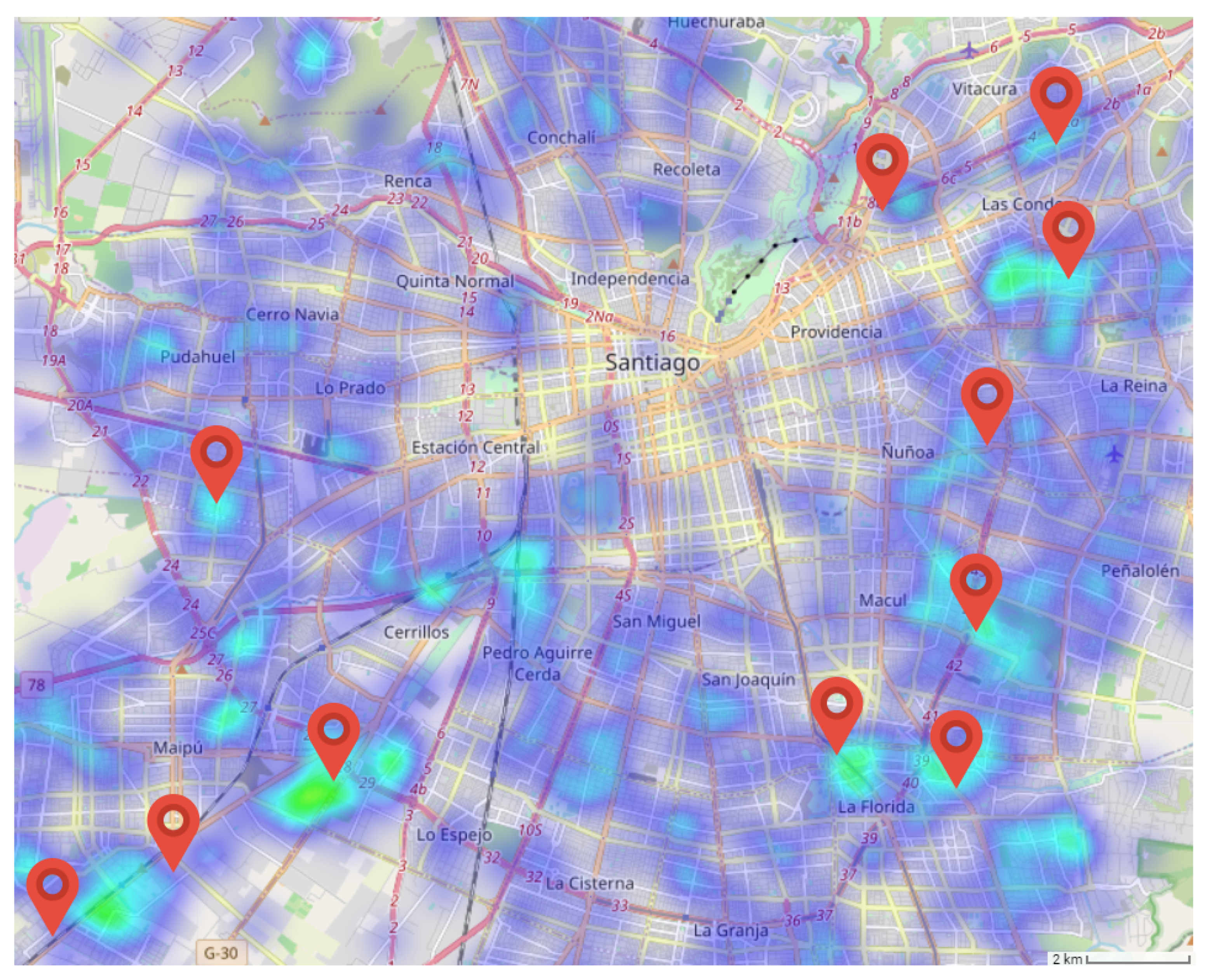
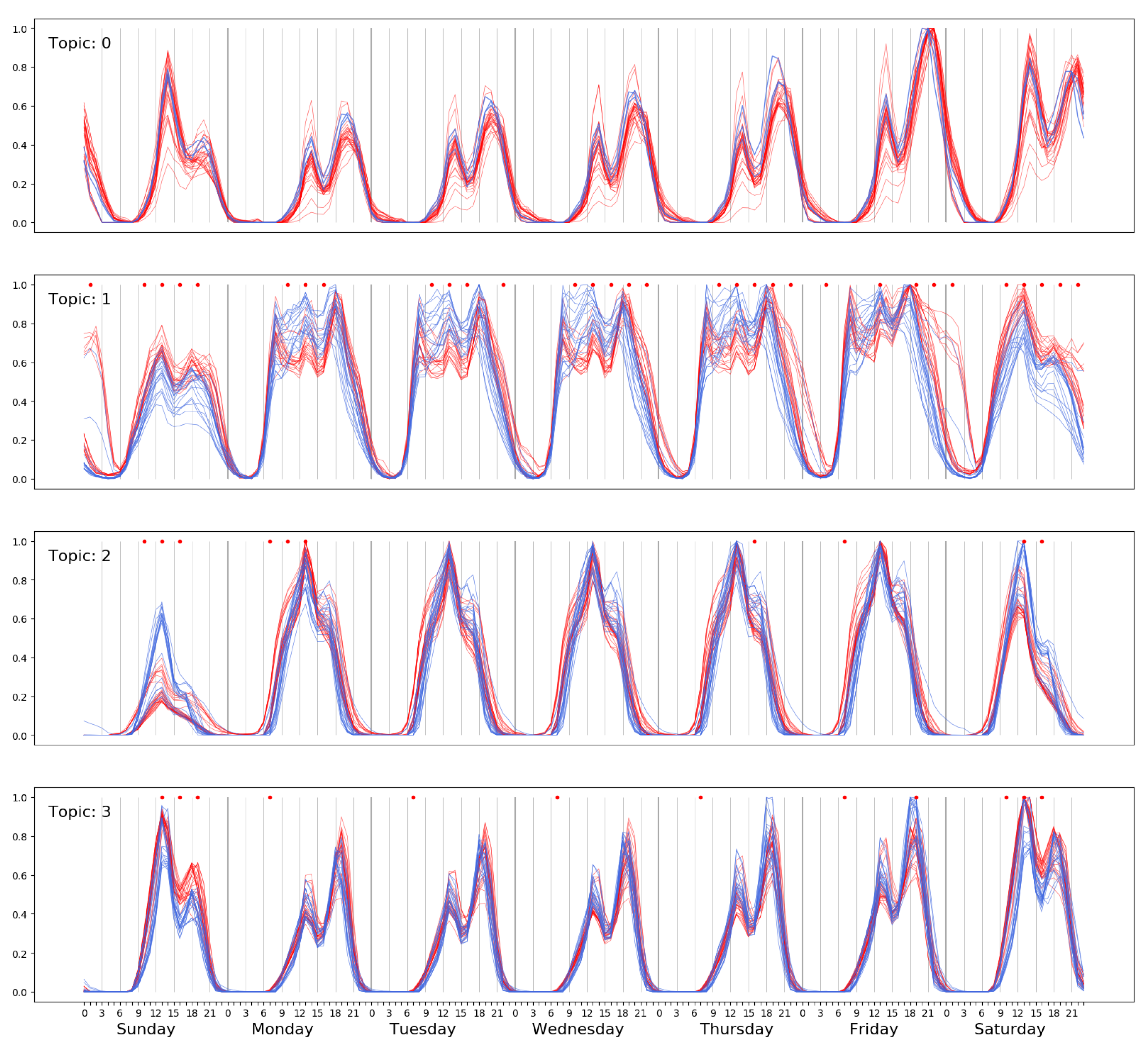
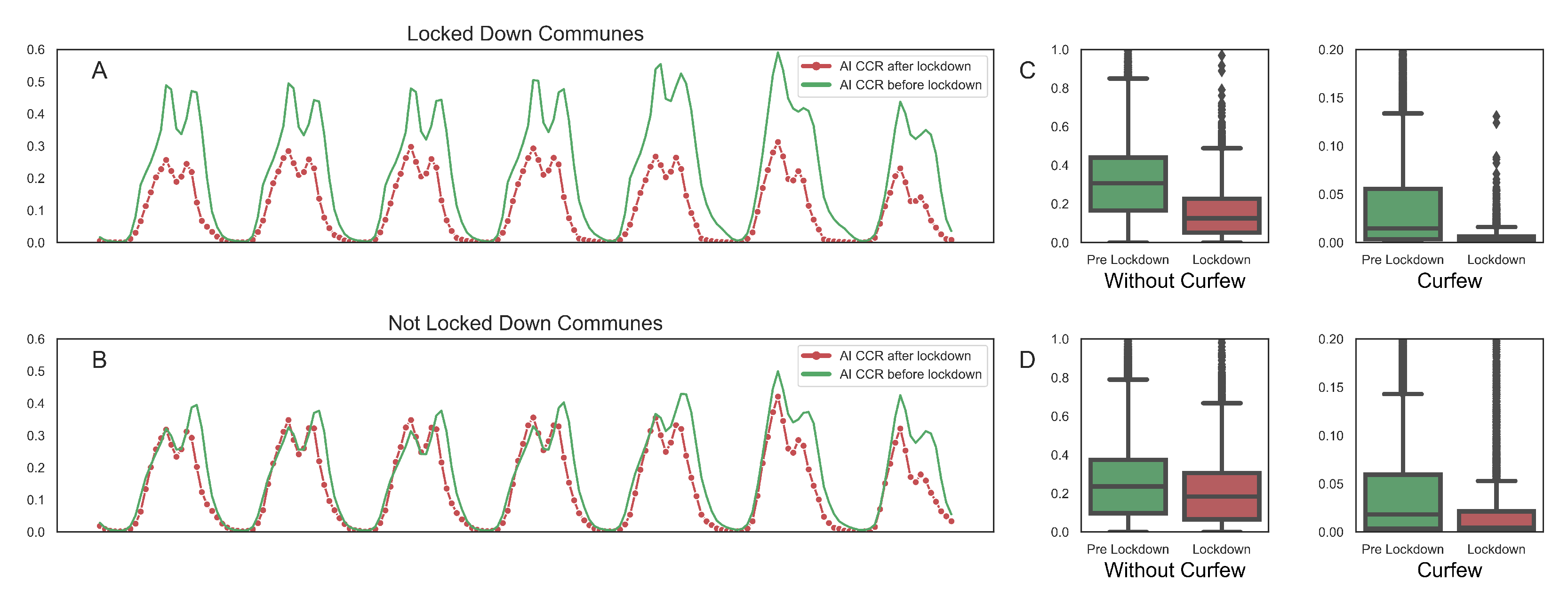
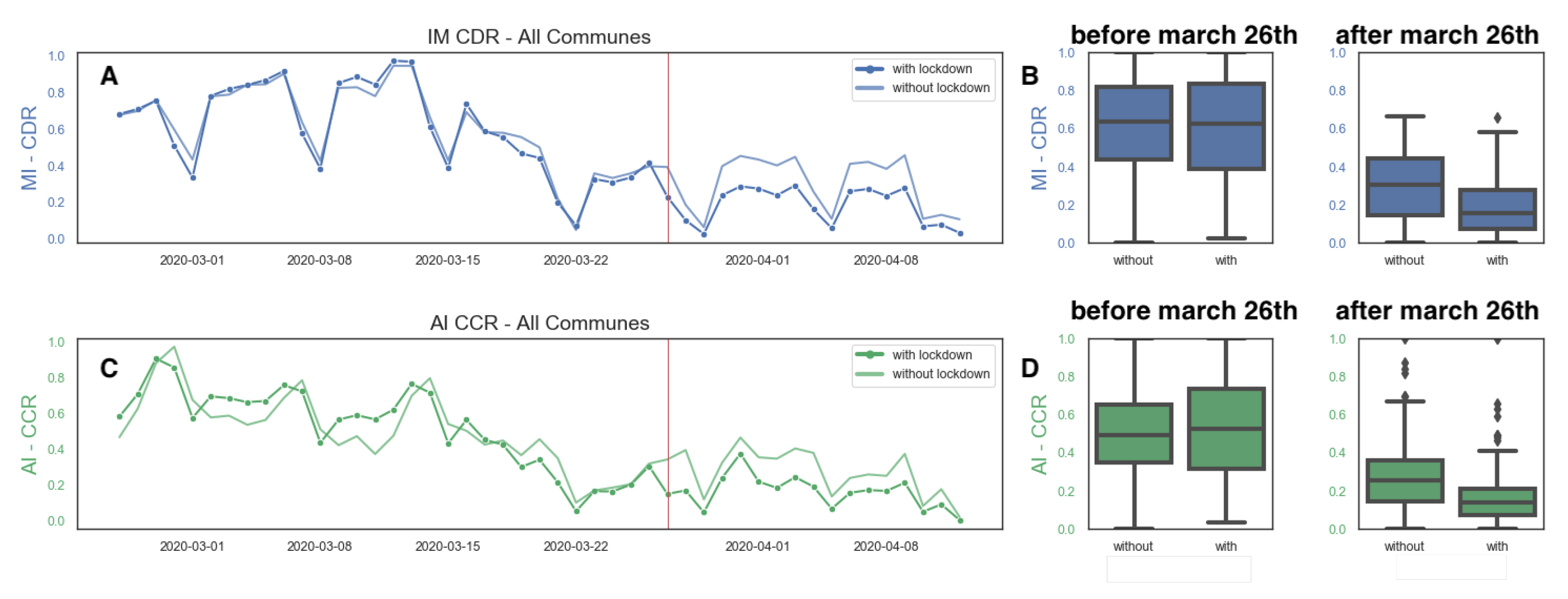
| CDR | |||||
|---|---|---|---|---|---|
| T0 | T1 | T2 | T3 | ||
| CCR | T0 | 0.63 | 0.82 | 0.72 | 0.42 |
| T1 | 0.80 | 0.76 | 0.76 | 0.70 | |
| T2 | 0.60 | 0.41 | 0.59 | 0.93 | |
| T3 | 0.69 | 0.63 | 0.94 | 0.56 | |
| Data Source | Lockdown Commune | Before March 26th | After March 26th | Reduction (%) |
|---|---|---|---|---|
| CDR | No | 0.614 | 0.303 | 50.7% |
| CDR | Yes | 0.604 | 0.183 | 69.7% |
| CCR | No | 0.503 | 0.272 | 45.9% |
| CCR | Yes | 0.520 | 0.158 | 69.6% |
Publisher’s Note: MDPI stays neutral with regard to jurisdictional claims in published maps and institutional affiliations. |
© 2021 by the authors. Licensee MDPI, Basel, Switzerland. This article is an open access article distributed under the terms and conditions of the Creative Commons Attribution (CC BY) license (https://creativecommons.org/licenses/by/4.0/).
Share and Cite
Muñoz-Cancino, R.; Rios, S.A.; Goic, M.; Graña, M. Non-Intrusive Assessment of COVID-19 Lockdown Follow-Up and Impact Using Credit Card Information: Case Study in Chile. Int. J. Environ. Res. Public Health 2021, 18, 5507. https://doi.org/10.3390/ijerph18115507
Muñoz-Cancino R, Rios SA, Goic M, Graña M. Non-Intrusive Assessment of COVID-19 Lockdown Follow-Up and Impact Using Credit Card Information: Case Study in Chile. International Journal of Environmental Research and Public Health. 2021; 18(11):5507. https://doi.org/10.3390/ijerph18115507
Chicago/Turabian StyleMuñoz-Cancino, Ricardo, Sebastian A. Rios, Marcel Goic, and Manuel Graña. 2021. "Non-Intrusive Assessment of COVID-19 Lockdown Follow-Up and Impact Using Credit Card Information: Case Study in Chile" International Journal of Environmental Research and Public Health 18, no. 11: 5507. https://doi.org/10.3390/ijerph18115507
APA StyleMuñoz-Cancino, R., Rios, S. A., Goic, M., & Graña, M. (2021). Non-Intrusive Assessment of COVID-19 Lockdown Follow-Up and Impact Using Credit Card Information: Case Study in Chile. International Journal of Environmental Research and Public Health, 18(11), 5507. https://doi.org/10.3390/ijerph18115507






